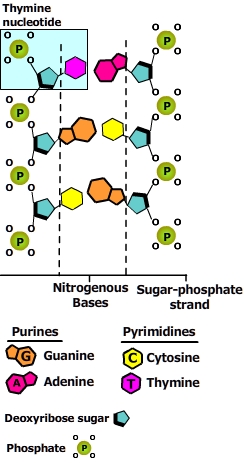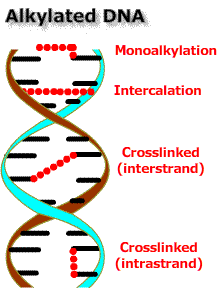Cytotoxic Chemotherapy
 Cancer is characterized by genetic mutations that inhibit or eliminate the normal controls on cell division. Many of today's non-surgical cancer treatments employ cytotoxic modalities that kill cancer cells or slows their replication by interfering with the apparatus of cell division. Cytotoxic chemotherapies focus on three strategies to inhibit cell division or induce apoptosis:
Cancer is characterized by genetic mutations that inhibit or eliminate the normal controls on cell division. Many of today's non-surgical cancer treatments employ cytotoxic modalities that kill cancer cells or slows their replication by interfering with the apparatus of cell division. Cytotoxic chemotherapies focus on three strategies to inhibit cell division or induce apoptosis:
- Block the formation of the DNA building blocks, deoxyribonucleotides: guanine, adenine, cytosine, thymine.
- Alter DNA structure by strand breaks, mismatched base pairing or enzyme malfunctions which inhibit DNA and RNA synthesis
- Inhibit mitotic spindles functions required to separate chromosomes during mitosis.
Alkylating agents (AA) were among the first anti-cancer drugs and are the most commonly used agents in chemotherapy today. "Alkylating agents act directly on DNA, causing cross-linking of DNA strands, abnormal base pairing, or DNA strand breaks, thus preventing the cell from dividing. Alkylating agents are generally considered to be cell cycle phase nonspecific, meaning that they kill the cell in multiple phases of the cell cycle. Although alkylating agents may be used for most types of cancer, they are generally of greatest value in treating slow-growing cancers. Alkylating agents are not as effective on rapidly growing cells. Examples of alkylating agents include chlorambucil, cyclophosphamide, thiotepa, and busulfan (SEER 2022).
Three types of DNA damage have been associated with AA therapy:
- AN AA binds to DNA bases (guanine, adenine, cytosine) altering the configuration of the DNA strand. The intracellular enzymes that normally repair DNA errors are stabilized at the alkyl molecule causing fragmentation of the DNA strand.
- AN AA binds to DNA bases creating a cross link that prohibits strand separation required for DNA synthesis or transcription.
- An AA bond creates a conformational change that leads to deletion or mismatch in base pairing (mutation).•
There are five groups of alkylating agents:
- Nitrogen mustard analogs
- Bendamustine - shares characteristics with the alkylators cyclophosphamide and chlorambucil; plus its benzimidazole ring may act as an antimetabolite and finally a butyric acid side chain confers water soluability. Bendamustine induces more extensive and durable double-stranded DNA damage stress, and mitotic catastrophe than cyclophosphamide, carmustine and melphalan (Kalaycio 2008).

- Mechlorethamine - results in DNA base pair mismatching, DNA interstrand crosslinking, the inhibition of DNA repair and synthesis, cell-cycle arrest, and apoptosis.
- Cyclophosphamide is converted in the liver to the active metabolites aldophosphamide and phosphoramide mustard, which bind to DNA, thereby inhibiting DNA replication and initiating cell death
- Chlorambucil alkylates and cross-links DNA during all phases of the cell cycle, resulting in disruption of DNA function, cell cycle arrest, and apoptosis.
- Melphalan alkylates DNA at the N7 position of guanine and induces DNA inter-strand cross-linkages, resulting in the inhibition of DNA and RNA synthesis and cytotoxicity against both dividing and non-dividing tumor cells.
- Ifosfamide is a prodrug activated in the liver. It alkylates and forms DNA crosslinks, thereby preventing DNA strand separation and DNA replication.
- Alkylsulfonates:
- Busulfan inhibits DNA replication and RNA transcription by DNA alkylation and DNA breaks.
- Hydrazines and Triazines:
- Altretamine may produce reactive intermediates which covalently bind to DNA, resulting in DNA damage.
- Procarbazine inhibits protein and DNA synthesis. It may also undergo auto-oxidation, resulting in the formation of cytotoxic free radicals which damage DNA through an alkylation reaction.
- Dacarbazine alkylates and cross-links DNA during all phases of the cell cycle, resulting in disruption of DNA function, cell cycle arrest, and apoptosis.
- Temozolomide cytotoxicity primarily due to methylation of DNA which alters expression of genes during division, resulting in inhibition of DNA replication.
- Nitrosureas: Can cross the blood brain barrier and form cytotoxic free radicals.
- Carmustine causes cross-links in DNA and RNA during all phases of the cell cycle, resulting in disruption of DNA function, cell cycle arrest, and apoptosis.
- Lomustine alkylates and crosslinks DNA, thereby inhibiting DNA and RNA synthesis
- Streptozocin alkylates DNA, forming inter-strand DNA cross-links and inhibiting DNA synthesis. Due to its glucose moiety, this agent is readily taken up by pancreatic beta cells, inducing diabetes mellitus at high concentrations. Unlike other nitrosoureas, streptozocin causes little myelosuppression.
- Metal salts:
- Carboplatin induces intrastrand and interstrand DNA cross-links, as well as DNA-protein cross-links. These carboplatin-induced DNA and protein effects result in apoptosis and cell growth inhibition
- Cisplatin forms highly reactive, charged, platinum complexes which induce intrastrand and interstrand DNA cross-links, as well as DNA-protein cross-links.
- Oxaliplatin forms both inter- and intra-strand platinum-DNA crosslinks, which result in inhibition of DNA replication and transcription and cell-cycle nonspecific cytotoxicity.
Plant alkaloids are a class of cell cycle specific cytotoxic agents derived from plant materials. They can be divided into 4 groups:
- Topoisomerase I inhibitors - Irinotecan and topotecan bind Topoisomerase (I) to DNA which leads to a DNA strand break. Normally topoisomerase relaxes the DNA supercoil by clips one strand of the DNA double helix which allows the helix to unwind a bit, then it re-attaches the cut ends. Relaxing a section of the DNA facilitates replication and transcription. These drugs inhibit the re-attachment process.
- Epipodophyllotoxins - Teniposide and etopiside poison Topoisomerase (II). Topoisomerase (II) relaxes the DNA supercoil. It clips both strands of the DNA double helix which allows the helix to unwind, then it re-attaches the cut ends of both strands. Relaxing a section of DNA facilitates replication and transcription. Poisoning of topoisomerase II causes cytotoxic double stranded DNA breaks.
- Taxanes - docetaxel and pacilitaxel stabilize the tubulin molecule within microtubules. Microtubules are dynamic structures that support cell shape, motion and form the mitotic spindle. Taxanes stop mitosis by preventing the shortening of mitotic spindle necessary to move the chromosomes to opposite poles of the cell. They are also believed to inhibit cell migration and angiogenesis.
- Vinca alkaloids - vinblastine, vincristine and vinorelbine cause disassembly of microtubes, blocking mitotic progression, resulting in cell death by apoptosis.
Anti-tumor antibiotics attack cancer cells by multiple mechanisms:
- Anthracyclines: - doxorubicin and daunorubicin lodge (intercalate) within the space between base pairs, blocking DNA replication and transcription. Anthracyclines allow the double strand breaks caused by topoisomerase II but inhibit the rejoining of the strand ends, leading to apoptosis
- Epirubicin hydrochloride - an anthracycline salt, intercalates into DNA and interacts with topoisomerase II, thereby inhibiting DNA replication and repair as well as RNA and protein synthesis. This agent also produces toxic free-radical intermediates and interacts with cell membrane lipids causing lipid peroxidation.
- Mitomycin - bioactivation results in an alkylating agent that forms cross links that inhibit DNA synthesis.
- Bleomycin - generates free radicals which damage cellular membranes, DNA and proteins
Antimetabolites are biochemical imposters that compete with the physiologic molecules necessary for normal cell function and replication. They often act by damaging DNA or impeding normal DNA synthesis or transcription.
- Folic acid antagonists interfere with metabolism of the essential nutrient folic acid. Folic acid is crucial for the synthesis the pyrimidine thymidine triphosphate (dTTP), one of the four deoxyribonucleic acids essential for DNA synthesis and repair. It is also involved in the synthesis of the precursors of adenine and guanine nucleotide bases. - See more at: http://www.sigmaaldrich.com/life-science/learning-center/biofiles/biofiles-5-6/folic-acid-metabolism.html#sthash.S9mRbfmK.dpuf
- Methotrexate inhibits enzymes necessary to synthesize the purine and thymine bases.
- Pemetrexed inhibits similar folate enzymes and has been approved for use in combination with cisplatin.
- Purine analogs are chemical substitutes for the purine bases guanine and adenine which are required for the normal synthesis of DNA or RNA.
- Mercaptopurine is metabolized to 6-thioguanosine monophosphate (6-thioGMP). Accumulation of 6-thioGMP can inhibit the syynthesis of the natural guanine nucleotide. When 6-thioGMP undergoes additional phosphorylation to 6-thioguanosine triphosphate, it can displace the normal guanine nucleotide during DNA synthesis leading to cytotoxic mutations.
- Azathioprine is a prodrug that is converted in vivo to mercaptopurine.
- Fludarabine is a fluorinated adenine molecule whose metabolite inhibits several vital enzymes causing the discontinuation of the synthesis of normal DNA and RNA.
- Thioguanine is a sulfur analog of guanine that is converted to 6-thioguanilyic acid (TGMP). The monophospahte TGMP inhibits the synthesis of purine nucleotides required for DNA sysnthesis. TGMP can displace the normal guanine nucleotide during DNA synthesis leading to cytotoxic mutations.
- Pentostatin binds to and inhibits adenine deaminase (ADA), an enzyme essential to purine metabolism. Inhibition of ADA appears to result in elevated intracellular levels of deoxyadenosine triphosphate (dATP) which may block DNA synthesis through the inhibition of ribonucleotide reductase.
- Cladribine has properties similar to pentostatin
- Pyrimidine analogs are chemical substitutes for the pyrimidines bases required for the synthesis of DNA or RNA
- Flurouracil (5-FU) inhibits thymidylate synthase, thereby blocking the synthesis of necessary nucleotides, causing severe damage and stopping DNA synthesis. In addition, 5-FU can replace uracil in RNA, resulting in corrupted protein synthesis. 5-FU can replace the pyrimidine base thymine in DNA causing strand breaks.•
- Capecitabine is an oral prodrug that is converted to flurouracil within the cell by a series of enzymatic reactions. Thymidine phosphorylase is one of those enzymes. Thymidine phosphorylase is often overexpressed in tumor cells. Over expression of thymidine phosphorylase by tumor cells results in higher levels of intracellular 5-FU then healthy cells.
- Floxuridine is rapidly converted to deoxyuridine mono-phosphate, a potent inhibitor of cell growth. However, flloxuridine is not widely used because deoxyuridine mono-phosphate is rapidly metabolized to flurouracil.
- Cytarabine metabolite Cytosine arabinoside is incorporated into the DNA by polymerase afterwhich elongation of the chain is stopped causing fragmentation and abnormal ligations.
- Azacitidine is a cytosine analog that inhibits DNA, RNA and protein synthesis when incorporated into DNA. It also inhibits DNA methylation which has been shown to allow the expression of tumor suppressor genes and to promote cell proliferation and differentiation.•
- Gemcitabine is converted to the nucleotides difluorodeoxycytidine diphosphate and difluorodeoxycytidine triphosphate.
- Difluorodeoxycytidine diphosphate inhibits ribonucleoside reductase which is the enzyme that catalyses the formation of deoxyribonucleotides from ribonucleotides. Thus, the >ribonucleotides ADP, GDP and CDP are not reduced to form the deoxyribonucleotides dADP, dGDP, dCDP required for the synthesize DNA.
- Difluorodeoxycytidine triphosphate inhibits the ability of polymerase to add the deoxyribonucleotides to the DNA chain. This terminates DNA chain elongation leading to apoptosis.•
Reference
Kalaycio M. (2008) Clinical Experience With Bendamustine: A New Treatment for Patients With Chronic Lymphocytic Leukemia. Clin Leukemia. 2(4):223-229
Accessed 1/30/2022
from - https://www.medscape.com/viewarticle/584893_2#:~:text=Bendamustine
%20displays%20a%20distinct%20pattern,3)%20induction%20of%20mitotic%20catastrophe.
SEER Training Modules, Types of Chemotherapy Drugs. U. S. National Institutes of Health, National Cancer Institute. 01/30/2022. https://training.seer.cancer.gov/
©RnCeus.com
 Cancer is characterized by genetic mutations that inhibit or eliminate the normal controls on cell division. Many of today's non-surgical cancer treatments employ cytotoxic modalities that kill cancer cells or slows their replication by interfering with the apparatus of cell division. Cytotoxic chemotherapies focus on three strategies to inhibit cell division or induce apoptosis:
Cancer is characterized by genetic mutations that inhibit or eliminate the normal controls on cell division. Many of today's non-surgical cancer treatments employ cytotoxic modalities that kill cancer cells or slows their replication by interfering with the apparatus of cell division. Cytotoxic chemotherapies focus on three strategies to inhibit cell division or induce apoptosis: